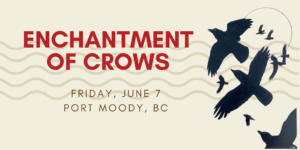Originally published by the Tri City News.
Otherworldly, they rise like luminous golden flames from the swamp’s black ooze. And, unmistakably, there is something in the air. Here on the wet coast there is no surer sign of spring. Skunk cabbages, modest of moniker but fabulous in form, once again decorate our lowland wet spots and gladden our winter-weary hearts with their vibrant, crayon-yellow capes. Within weeks, their flower parts will be overshadowed by enormous brilliant green leaves that are said to be the largest of any native plant in Canada.
The yellow skunk cabbage of this region, Lysichiton americanum, has numerous relatives the world over. It belongs to the Arum plant family which includes the charming jack-in-the-pulpit, a plant I loved as a child in Ontario, and the burgundy coloured skunk cabbage of the Eastern seaboard which emits a much stronger odour than does ours. Then there is the flesh-pink dead horse arum of Corsica which University of Adelaide’s Roger Seymour says “looks and smells like the south end of a horse that died going north.”
In Japan, where it is protected, the stately white skunk cabbage invites massive spring pilgrimages to bogs in the Hokkaido region. My friend, photographer Kiyoshi Takahashi, tells me that its Japanese name, Mizu Basho, translates as ‘water’ plus ‘banana-like plant’ and that the name is considered sacred by Buddhists. It has further significance because Basho is also the name of a revered 15th century Japanese poet.
On this side of the Pacific, we hold skunk cabbage in somewhat less regard. Our feelings towards it range from disdain to gentle affection and we only rarely get poetic. Laura Gamache, however, paints a delightful image:
Three brown dogs huff and snuffle
into the high stench
of a sump of standing water
teeming with rabbit ears
of fledgling skunk cabbage;
their tails waving yes
and yes
and yes.
The family name Arum comes from the Arabic word for fire (ar). If you were ever foolhardy enough to taste it, you’d know why. Irritating needle-like crystals of calcium oxalate would puncture the mucous membranes of your mouth and throat, probably spelling the end to your days of sampling nature’s larder. Early First Nations people knew that cooking skunk cabbage leaves and roots in many changes of water neutralized the chemical to provide a reliable but not very choice source of calories when food was scarce.
Bears seem unbothered by those sharp crystals and seek out the leaves of skunk cabbage in spring. Some say the plant acts as a cathartic that gets their sluggish digestive systems into high gear after winter’s inactivity. My personal connection to this idea was a trip to an estuary on the mid-coast several years ago that yielded the unforgettable image of a gigantic skunk cabbage leaf freshly grazed by a grizzly. The top half of the thigh-high leaf was bitten off in a perfect semi circle. Big leaf. Big bear!
According to BC ethnobotanist Nancy Turner, the waxy leaves of skunk cabbage were used to wrap, carry, dry and store many foods. When vegetables, meat and fish were steamed, it was common to encase each food separately in skunk cabbage leaves. Not only were the juices of each food isolated, but the wrapping imparted no additional flavour. Skunk cabbage leaves were folded into cones to make disposable, biodegradable drinking cups. In times of famine when the Haida had no bait for their yew wood fish hooks, they used its roots as lures. The tuber looks like a bunch of fleshy white fingers and can trick a halibut into thinking it’s gulping up an octopus.
There’s an aboriginal legend about the origin of the flowering part of this plant. Long ago there were no Salmon. The People ate Skunk Cabbage leaves and roots. Finally, the Salmon came up the river and Skunk Cabbage, in human form, stood up and alerted the People to their arrival. In return, Skunk Cabbage was given an elk-skin blanket and a war club.
Look deep inside the yellow bract of a skunk cabbage. You may see tiny beetles and other insects crawling on the fleshy spike which is pimpled with tiny flowers. Attracted by the scent, these bugs assist pollination. But here’s the amazing part. Like warm-blooded animals, the skunk cabbage family can generate heat, in some cases enough to melt the snow around them! This gives an early advantage over other flowering plants by vaporizing scents into the chilly spring air. According to author Daniel Mathews, our west coast cabbages release different odours at different temperatures to attract a variety of insects. Bugs may even be drawn to the heat itself. And some scientists think that the warmth and smell have evolved together to mimic a dead animal in which microbial processes raise the temperature of the carcass. Come hither, blowflies.
In the weeks ahead, perhaps you’ll spot this distinctive plant in a local ditch or wetland. If so, inhale that West Coast spring aroma, celebrate the spectacle of this bog beauty and marvel at its magic. Then would you consider signing my petition for a name change to ‘swamp lantern’? This plant deserves more respect!


